CLARREO (Climate Absolute Radiance and Refractivity Observatory)
EO
Atmosphere
Radiation budget
NASA
The Climate Absolute Radiance and Refractivity Observatory (CLARREO) mission is a climate research satellite by the National Aeronautics and Space Administration (NASA). CLARREO is expected to launch in the late 2020s, with a smaller pathfinder mission expected to launch to the International Space Station in late 2023.
Quick facts
Overview
| Mission type | EO |
| Agency | NASA |
| Mission status | Approved |
| Measurement domain | Atmosphere |
| Measurement category | Radiation budget |
| Measurement detailed | Upward short-wave irradiance at TOA |
| Instruments | CLARREO Pathfinder Reflected Solar |
| Instrument type | Hyperspectral imagers |
| CEOS EO Handbook | See CLARREO (Climate Absolute Radiance and Refractivity Observatory) summary |
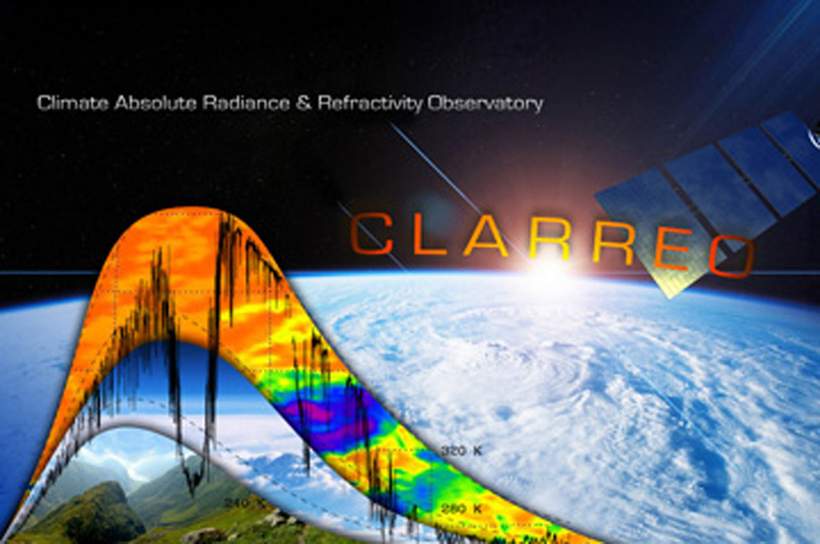
Summary
Mission Capabilities
The primary objective of CLARREO is to improve humankind's understanding of climate change through the measurement of the Earth’s infrared emission spectrum at very high accuracy and traceable to SI units and radiometric standards. CLARREO will also be used as an orbiting calibration standards laboratory designed and optimized for the calibration of sensors on operational and research missions that will then provide the global space/time sampling needed for climate change detection.
CLARREO will carry the Absolute Radiance Interferometer (ARI) - an infrared spectrometer designed to serve as an on-orbit radiometric reference with the ultra-high accuracy needed to optimize measurement of the long-term changes of Earth’s atmosphere and surface. ARI consists of a Calibrated Fourier Transform Spectrometer (CFTS), calibrated on-orbit in the traditional way using an ambient onboard blackbody reference and a space view, and an On-orbit Verification and Test System (OVTS) that provides end-to-end calibration verification with direct on-orbit traceability to absolute standards. The OVTS consists of fundamentally new subsystems including the On-orbit Absolute Radiance Standard (OARS), On-orbit Cavity Emissivity Modules (OCEMs), and an On-orbit Spectral Response Module (OSRM).
Performance Specifications
The CLARREO mission requirements specify that the thermal infrared spectrometer should have a systematic error of less than 0.06 K, and a spectral coverage of 2-20 m-1, with 5mm-1 unapodized spectral resolution. The instrument should be nadir pointing, with systematic error of less than 0.2°, nadir field of view 25-200km, and less than 200 km between successive spectral along the ground track. The prototype design has a 4-port fourier transform spectrometer, a mass of 76kg, 124 W average power, and images 2.5 GB per day.
The reflected solar (RS) spectrometer should have a systematic error less than 0.3% of Earth's mean reflectance, with 320-2300nm of spectral coverage. Samples should be collected at a width of 4nm, with spectral resolution of 8nm. The nadir field of view should be 0.5km for a 100km wide swath, and the instrument should be pointable in azimuth and elevation for solar, lunar, reference intercalibration views. The prototype design has a dual grating spectrometer, 69kg total mass, 96 W average power, and images 30 GB per day.
CLARREO will be placed in a 90° ± 0.2° orbit for full diurnal sampling twice per year, at an altitude of 609±0.2 km, and 61 day repeat cycle.
CLARREO (Climate Absolute Radiance and Refractivity Observatory)
In January 2007, the United States’ National Academy of Science released a report entitled: “Earth Science and Applications from Space: National Imperatives for the Next Decade and Beyond” which was requested by NASA, NOAA, and the US Geological Survey (USGS). This “decadal survey” recommended a series of space missions for NASA and NOAA to undertake over the course of the next decade to further humankind's knowledge of the Earth system. Along with the missions themselves, the decadal survey provided a notional schedule for implementation of these missions. Among the first set is a mission called CLARREO (Climate Absolute Radiance and Refractivity Observatory).
The primary objective of the CLARREO mission is to improve humankind's understanding of climate change through the measurement of the Earth’s infrared emission spectrum at very high accuracy and traceable to the international system of units (Système International d'Units, referred to commonly as “SI”) and radiometric standards - and to use the CLARREO measurements to cross-calibrate other spaceborne sensors. 1) 2) 3)
As a response to the decadal survey report, NASA, NOAA and USGS conducted a first CLARREO Workshop on July 17-19, 2007 at the University of Maryland Conference Center, College Park, MD, to discuss possible mission concepts of the challenging CLARREO mission recommendations and to organize an approach to implementation. It turns out that a constellation of three minisatellites is needed on a long-term basis to comply with the findings of the decadal survey report. 4) 5) 6) 7) 8) 9) 10) 11)
The CLARREO mission envisions a series of very accurate and stable interferometers (Fourier Transform Spectrometers) measuring the infrared spectrum at high accuracy and stability. The nominal measurement requirements from the decadal survey are:
- Spectral Range: 5 to 50 µm (2000 to 200 cm-1)
- Spectral resolution: 1 cm-1
- IFOV (Instantaneous Field of View): < 100 km
- Absolute accuracy: 0.1 K (3σ)
- SI (Systeme International) traceability: entire spectrum
- Time to record 1 spectrum: < 8 seconds.
The specific goals of the CLARREO mission are to provide a benchmark climate record that is global, accurate in perpetuity, tested against independent strategies that reveal systematic errors, and pinned to international standards (SI traceability). Key climate variables to be sensed by spaceborne instruments refer to such parameters as solar irradiance, cloud & aerosols properties, radiation budget, vegetation, ocean color, snow & ice.
The objective is to use CLARREO as an orbiting calibration standards laboratory designed and optimized for the calibration of sensors on operational and research missions that will then provide the global space/time sampling needed for climate change detection. CLARREO will provide the SI traceable accuracy in orbit for these sensors at absolute accuracy levels sufficient to observe decadal climate change at a signal-to-noise level of at least 5:1.
These objectives are also in agreement with the GCIS (Global Space-based Inter-Calibration System), a new WMO (World Meteorological Organization) program initiative whose overarching goal is the ensure the comparability of satellite measurements provided at different times, by different instruments under the responsibility of different satellite operators.
The CLARREO climate accuracy requirements for variables determined from reflected solar radiation are shown in Table 1, expressed as stability per decade. The objective is to calibrate operational and research satellite instruments with CLARREO to enable these levels of stability to be achieved by the satellite observing system.
Variable | Stability/decade (instrument gain change in %) |
Shortwave cloud radiative forcing (cloud feedback) | 0.25 |
Visible cloud optical depth (cloud feedback) | 0.40 |
Cloud particle size (1.6 mm and 2.1 mm wavelength) | 0.50 |
Vegetation | 0.80 |
Ocean color | 1.00 |
Surface albedo | 1.00 |
Aerosols (gain) | 1.50 |
Aerosols (polarization) | 0.25 |
Table 1: Accuracy requirement by variable
The FIR (Far Infrared) region of the Earth's emission spectrum, commonly defined for wavelengths in the range of 15-100 µm, requires technology demonstrations prior to the implementation of CLARREO since this region has not been comprehensively observed from space for the purposes of climate science. The FIR region contains over half of the outgoing longwave radiation exiting the Earth and its atmosphere; it is fundamental to determining the radiative feedback from water vapor associated with climate change; it is responsible for approximately half of the greenhouse effect that keeps the Earth at temperatures habitable by humans; and it contains a large portion of the radiative effects of cirrus on climate. The FIR observations were endorsed with unanimity at the CLARREO Workshop in July 2007 (Ref. 1).
Collaborations: International collaborations, e.g., TRUTHS (Traceable Radiometry Underpinning Terrestrial and Helio Studies), amongst scientists and engineers are needed from both CLARREO and the operational and research missions whose instruments CLARREO will calibrate and that the CLARREO mission fits well within frameworks such programs as GEOSS (Global Earth Observation System of Systems) and CEOS (Committee on Earth Observation Satellites).
NASA/LaRC and NOAA share responsibility for CLARREO. 12)
• The NASA portion involves the measurement of spectrally resolved thermal IR and reflected solar radiation at high absolute accuracy. Coupled with measurements from on-board GPS radio occultation receivers, these measurements will provide a long-term benchmarking data record for the detection, projection, and attribution of changes in the climate system. In addition, the SI traceable radiances will provide a source of absolute calibration for a wide range of visible and IR Earth observing sensors, greatly increasing their value for climate monitoring.
• The NOAA component involves the continuity of measurements of incident solar irradiance and Earth energy budget by flying the TSIS (Total Solar Irradiance) and CERES (Clouds and the Earth`s Radiant Energy System) sensors that were removed from the NPOESS (National Polar-orbiting Operational Environmental Satellite System) mission.
Sampling considerations
Sampling needs: To meet the climate accuracy goals defined in the ASIC3 (Achieving Satellite Instrument Calibration for Climate Change) and earlier reports, CLARREO must not only be highly accurate, stable, well characterized, and have a means of tracking stability on orbit, but it must also have the appropriate characteristics to enable calibration of operational and research satellite instruments.
Spectral sampling: The main driver for the spectral sampling requirement is the need to convolve CLARREO spectra with the spectral response functions of the various instruments being calibrated by CLARREO.
Spatial sampling: The ideal CLARREO spatial sampling was determined to be 1 km IFOV over a 100 km swath. This would permit calibration of moderate-spatial resolution instruments by averaging over 100-km regions observed by both CLARREO and the instrument being calibrated within a few minutes of one another. For instruments with coarser spatial scales (e.g., radiation budget instruments), the 1 km CLARREO pixel data could be spatially averaged into the larger footprint of the instrument being calibrated (after weighting by the instrument point-spread function).
Angular sampling: Initially it was proposed to restrict the angular coverage to the nadir-to-45º range, but because some instruments (e.g., MISR) can observe to 70º in the along-track direction, the group decided to extend the range to 70º.
Pointing capability: It was concluded that a pointing capability is critical to CLARREO’s ability to calibrate other instruments at climate accuracy. The intercalibration involves not only matching samples in space and time, but also in viewing geometry. That is, CLARREO must observe a scene from the same view angle as the instrument being calibrated.
Temporal sampling: The temporal requirement is driven by the need to calibrate satellite instruments at equator -to-polar latitudes approximately every 3 months. The equator-to-pole requirement is driven by the need to verify calibration accuracy in a full range of climate regimes, especially to verify spectral response functions of filter instruments like MODIS, VIIRS, GOES, and CERES. The 3-month time period is driven by the need to resolve any rapid shifts in instrument calibration, as well as the ability to do the calibration while the instrument gain is relatively constant.
Value of information for Climate Observing Systems
In early 2010, the United States government published estimates of the social cost of carbon for use in regulatory cost–benefit analysis IWG SCC 2010 (Interagency Working Group on Social Cost of Carbon). The estimates concern the monetized climatic benefits of regulations for the transportation, electricity, and other economic sectors that reduce carbon emissions. Since formal publication of the IWG SCC 2010, it has been employed in more than 20 regulations ranging from fuel economy standards for vehicles to air pollution regulations for power plants to energy efficiency standards for appliances and equipment. 14)
This paper uses the IGW-SCC to compute the VOI (Value of Information) provided by projected COS (Climate Observing System) improvements designed to learn about key climate parameters faster than existing observations. The key to computing this VOI is to place this new COS in a decision context where its information can be used. Indeed, if the new information is not used, then the COS can be valued only in terms of pure knowledge accretion, and its potential social value is lost. The VOI formalism is the essential tool in structuring the decision problem in which the social value of a new COS can be computed. Although based on the US baseline for computing the IGW-SCC, the climate damages are worldwide. Switching from a BAU (Business As Usual) to a reduced emissions path upon achieving a given level of confidence that a climate parameter has been exceeded avoids damages worldwide whose NPV (Net Present Value) runs into tens of trillions of US dollars.
The spaceborne CLARREO observing system illustrates the VOI calculations of COS. Driving this choice is the fact that key accuracy parameters of this system as compared to the current spaceborne systems have been computed. The initial VOI estimate uses several simplifying assumptions. Besides the assumptions underlying the IGW-SCC, the integrated assessment model DICE coupling climate change to economic damages is used, and the decision context in many ways is simplified. Sensitivity tests of selected parameters suggest that, while total societal costs vary greatly, the VOI of accelerated climate change information is relatively robust against the selection of a reduced emissions scenario, a climate trigger for switching to the reduced emissions scenario, and the level of confidence required for the switch. The main message is that VOI calculations of new COSs are possible, and should be used to assess their potential contribution, beyond a current baseline, of new observing systems.
For IGW-SSC calculations, equilibrium CS (Climate Sensitivity) is one of the primary uncertainties. CS is defined as the equilibrium global temperature increase for doubled CO2; its cumulative frequency distribution and probability density function used in IGW-SCC.
Economic damages (worldwide) from carbon emissions are computed with an integrated assessment model. The more accurate observing system acquires the required confidence earlier and switches sooner to the reduced emissions path, thereby avoiding more damages which would otherwise be incurred by BAU emissions. The difference in expected net present value of averted damages under the two observing systems is the VOI of the new observing system relative to the existing system. As illustration, the VOI for the proposed spaceborne CLARREO system relative to current spaceborne systems is computed. Depending on details of the decision context, the VOI ranges from 2 to 30 trillion US dollars.
While CLARREO is used as the example to demonstrate the concept, societal decisions will be made using many climate change signals, so that this value should be considered to be relevant to an improved overall COS. A number of caveats apply to these calculations:
1) Following the IGW-SCC, only damages are considered in computing the social cost of carbon. Switching to a reduced emissions scenario undoubtedly entails costs which themselves depend on many uncertain parameters on both the climate and the economic side. It is important to appreciate that the IGW-SCC is not solving a social choice problem, it is computing a price that should be added to the price of carbon to account for environmental damages. As analogy, the amount we should be willing to pay for a low emissions car depends on the damages averted by reduced emissions. In the same way, the amount we should be willing to pay for an improved COS depends on the value of averted damages. This is what the VOI computes. Mitigation costs are not included in the analysis as they have no traceability equivalent to that for damages in the IGW-SCC. For example, mitigation cost estimates in the IPCC (Intergovernmental Panel on Climate Change) report vary by a factor of 12 for achieving stabilization of CO2 at 535–590 ppm. Future VOI developments should examine inclusion of these costs. 15) 16)
2) Again following the IGW-SCC, only CS is considered uncertain. There are many other uncertain parameters in these calculations, including the carbon cycle, ice sheet dynamics, economic damages, and abatement costs. Agreement on uncertainty distributions for these other uncertain parameters would enable improvements in the present calculations.
3) Observing the decadal temperature rise is not the only way to learn about CS, nor is it the best way. Observing cloud radiative forcing and temperature change together provide more direct information about cloud feedbacks and therefore CS.
4) Any real decision context is more complex than that modeled here. For example, these calculations assume that a switch to a reduced emissions scenario would happen instantaneously, on a time scale discretized into 5-year steps. A policy ramp would be more realistic, involving additional decision parameters. Since this policy ramp would apply to switches under both the new and current observing systems, its effect might be relatively small on VOI values.
Despite these caveats, the results show that a uniform yardstick, however imperfect, can enable calculations supporting complex social decisions. The same method could be used with improved climate and economic models and with a broader range of uncertain inputs. This in itself will hopefully motivate improvements in second generation tools for computing the social cost of carbon, as well as a better understanding of the economic value of future advances in climate observations.
Note: The interested reader is referred to Ref. 13) for more background on the social cost estimates. In 2015, a further climate policy paper was published by essentially the same team. 17)
Challenges in climate prediction
The science value of the CLARREO mission has been formulated in terms of decadal change in climate forcing, response, and feedbacks relevant to the information content in the CLARREO RS and IR spectra and RO observations, as well as its ability to act as a reference radiometer in orbit to improve the accuracy of other reflected solar and infrared sensors. Figure 1 shows a schematic summarizing the contributions of the CLARREO RS/IR/RO observations to climate change using a climate feedback schematic. 18)
The published climate change literature has been used to derive the CLARREO requirements in terms of the mission's ability to measure decadal change for some of the most important elements of the climate system: temperature, water vapor, cloud properties, radiative fluxes, and surface properties including albedo. CLARREO decadal change observations are also key to reducing uncertainties in the climate feedbacks that drive uncertainty in climate sensitivity. Climate feedbacks in order of uncertainty in their magnitude are cloud feedback, temperature lapse rate/water vapor feedback, and snow/ice albedo feedback. In addition, CLARREO will help quantify radiative forcing from anthropogenic changes in land albedo, will confirm the effect of greenhouse gases on the infrared emissions to space, and will make some modest contributions to aerosol direct radiative forcing.
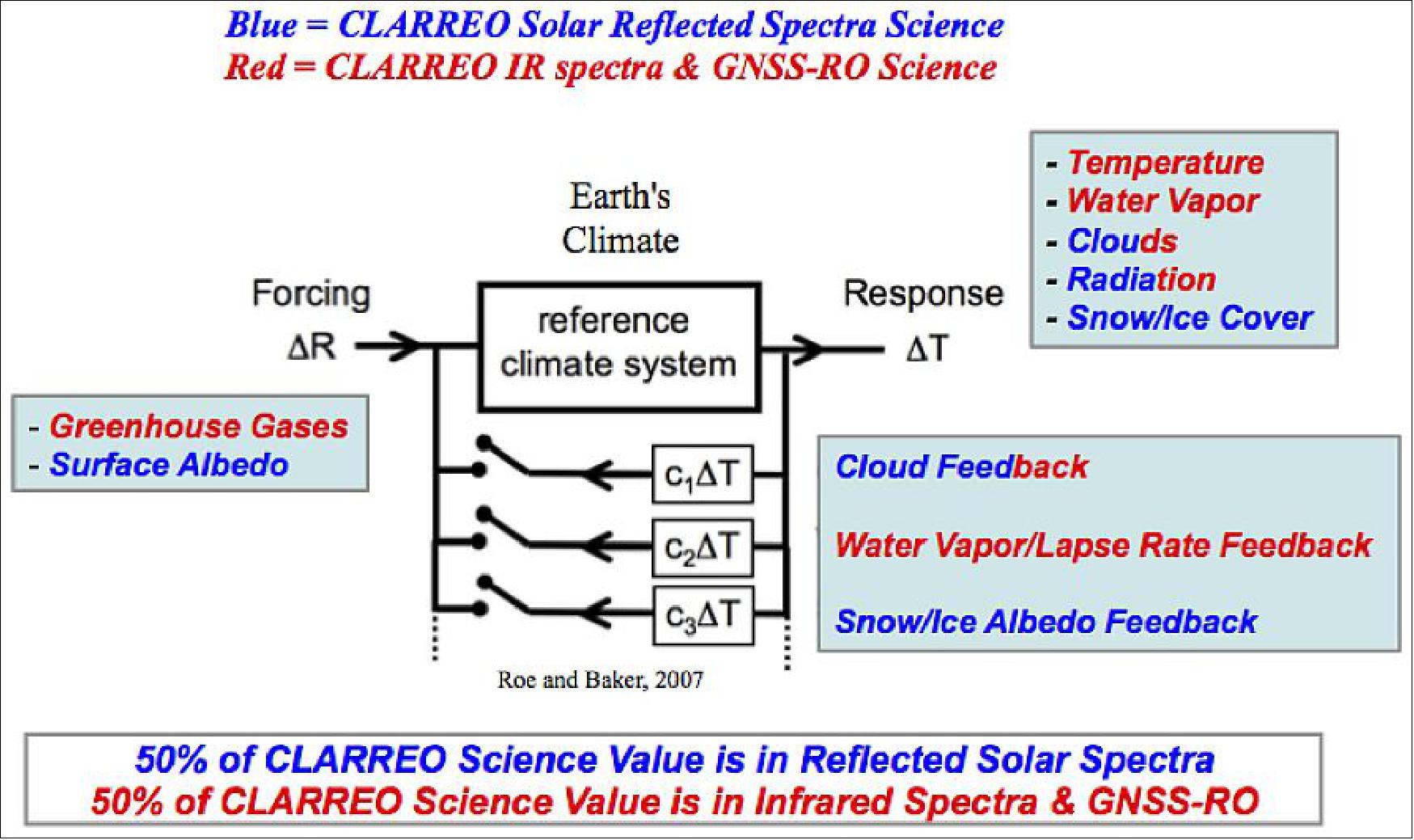
Figure 2 provides a diagram that illustrates the role of the CLARREO mission in relationship to other climate missions. Climate model process improvements (blue dashed box) typically require observations on short time and space scales. For example, NASA A-train satellite process data contain information on the instantaneous vertical profiles of clouds, aerosols, atmospheric state, and radiation. These process observations drive improvements in cloud and aerosol processes that can be incorporated into improved representation in climate models. The new climate models are then used in assessments of climate change.
The models are driven by past and future natural and anthropogenic climate forcings to provide predictions of climate change over time frames from several years to decades to centuries. These climate predictions are then tested on decades of past climate observations, with the purpose of estimating the uncertainty of future climate projections (orange dashed box) based on anticipated human emissions of aerosols and greenhouse gases. This same algorithm is used to evaluate the attribution of climate change to natural and anthropogenic causes. The resulting uncertainties in climate prediction and the attribution studies are then used to guide critical societal decisions on climate change mitigation and adaptation. They are also used to determine future improvements needed in both climate observations and climate models.
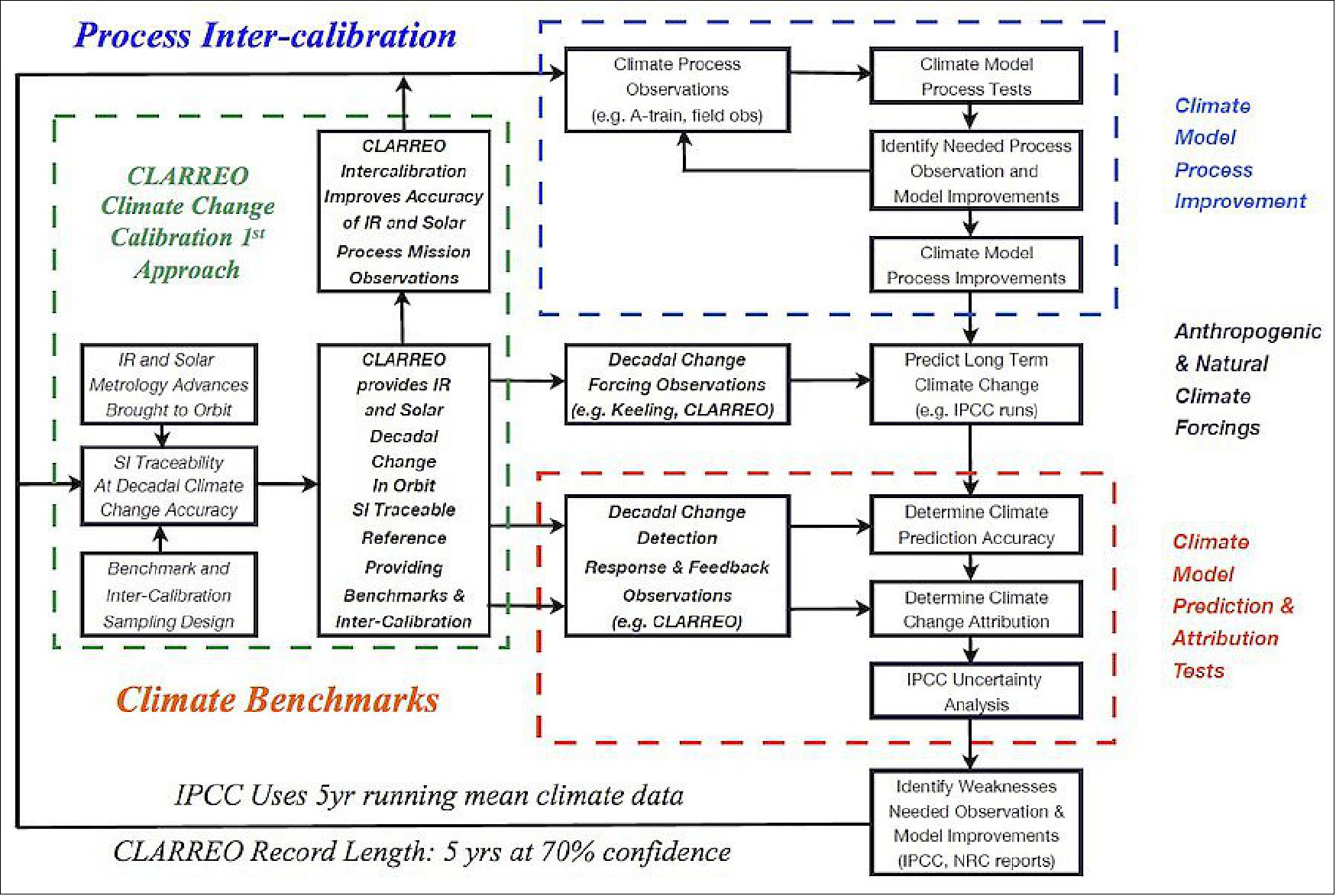
Legend to Figure 2: Most NASA climate missions are designed to improve climate processes such as clouds (blue box). CLARREO brings metrology advances (green box) from laboratories on Earth and launches them into orbit to provide a broad range of climate benchmarks (orange box) critical to observing climate change and to testing the accuracy of climate change predictions. CLARREO accomplishes this through a) spectral benchmarks fingerprinting, and b) providing in-orbit Reference Inter-calibration to other reflected solar and infrared instruments.
Unfortunately, most of the global satellite data sets are not yet accurate enough to be used to test the small but critical signals of decadal change, since accuracy requirements are less strict for climate process studies. The CLARREO measurements are designed to fill this gap in the climate observing system by establishing for the first time satellite observations sufficiently accurate for decadal change. CLARREO relies on advances in metrology made over the past 10 years for much more accurate calibration of solar and infrared instruments, and on the advances in using radio occultation to probe the Earth's atmosphere (green box). CLARREO also detects for the first time over 95% of the entire spectrum of the Earth's thermal emitted radiation (200 - 2000 cm-1 or 5 to 50 µm wavelength) and its solar reflected radiation (350 - 2300 nm). This is the same spectrum of energy that drives the radiative forcing of climate change, the climate system response, and the resulting feedbacks that change climate sensitivity.
The full spectral coverage and accuracy of CLARREO impacts a wide range of essential climate variables. The highly resolved accurate spectra allow CLARREO to sense spectral fingerprints of decadal climate change. They also allow CLARREO to serve as a reference spectrometer in orbit to calibrate other infrared and reflected solar instruments. In this sense, CLARREO is a metrology lab in orbit, and can anchor a substantial portion of the global satellite monitoring system because its spectral range spans many existing and planned instruments. An additional benefit of CLARREO as a metrology lab in orbit is the ability to improve and simplify use of process data satellite missions, enabling more accurate and consistent observations for a wide range of Earth science and application studies from space. An example is the ability to improve the consistency of observations from similar instruments on several spacecraft such as land resource sensors or weather sensors.
While most satellite missions strive for smaller spatial scales to resolve increasing details of Earth processes, a climate change metrology mission like CLARREO must focus on larger time and space scales. An example of the spatial scales of climate change can be seen clearly in the spatial patterns of critical climate feedbacks such as cloud, temperature, water vapor, and surface albedo feedbacks shown in Figure 5, taken Ref. 21). The results from a wide range of climate models show that these feedbacks occur on spatial scales of 2000 km or larger and are often very zonal in nature, as shown for the temperature, water vapor, and surface albedo feedbacks. We conclude that the observing time/space scale requirements for the CLARREO mission will focus not on high spatial resolution instantaneous measurements common to most process missions, but rather on the larger spatial and longer temporal scales that capture decadal changes in forcings, responses, and feedbacks.
The IPCC typically uses a 5-year running mean filter on all decadal time series in order to reduce the level of natural variability from ENSO (El-Nino - Southern Oscillation) events, which typically have a 3 to 5 year period. As a result, the CLARREO observations focus primarily on the ability to observe annual and longer time scales, with an initial benchmark climate record of at least 5 years. A recent analysis confirms that 5 years provide a lower bound on the record length needed to accurately quantify feedbacks in coupled ocean atmosphere models. Focusing on longer time scales also suggests that all measures of CLARREO accuracy will be determined using thousands of observations, never just a few as in weather or climate process missions. While low random noise from an instrument is a high priority for process satellite missions, it will be a much lower priority for CLARREO. The CLARREO approach is therefore to average measured spectra over large time and space domains, which results in the reduction of uncertainty due to random noise as the Gaussian instrument random noise averages down to an insignificant level over time. On annual and longer timescales the main uncertainty in the measured CLARREO radiances becomes systematic uncertainty and not random noise. In the CLARREO temporally and spatially averaged data products (e.g., zonal annual means), the uncertainty is due to a combination of the radiometric uncertainty and the uncertainty in the time and space sampling of the Earth system.
The effective insensitivity of CLARREO mission objectives to higher random instrument noise levels in turn allows CLARREO to use smaller instruments with smaller optics and less cooling of detectors. This is especially important to enable CLARREO to measure the far-infrared portion of the spectrum. Existing pyroelectric detectors are sensitive in the far-infrared (wavelengths between 15 and 100 µm) and operate near room temperature. Both of these changes lead to much smaller, lighter, lower power, and lower cost instruments. Smaller instruments can use smaller spacecraft and launch vehicles, all of which drive down costs for the climate observing system. We conclude that the trade space and requirements for a mission focused on high absolute accuracy for decadal change, results in a very different design from those for weather or climate processes. In fact, when working on the fundamental Level 1 mission requirements for CLARREO, NASA had no history or analog for accommodating such requirements.
Mission and Instrument Design Considerations
The CLARREO requirements (Table 2) were used to develop instrument designs, with the additional goal of reducing instrument size to minimize mass, power, and cost. A wide range of mission orbits, spacecraft, and launch vehicle designs were considered to optimize the requirements. Prototype designs were developed for all of the instruments, with similar designs being used to verify calibration accuracy tests in collaboration with NIST.
The CLARREO instruments are much smaller than typical weather instruments such as VIIRS (252 kg), CrIS (152 kg), and IASI (210 kg). This allows small spacecraft and launch vehicles. The entire suite of CLARREO instruments would require a satellite with mass of only one-third to one-sixth that of the flagship missions Terra, Aqua, or NPP.
CLARREO instrument design represents an advance in absolute calibration over existing instruments. Figure 3 a demonstrates how this is achieved for the thermal infrared interferometer, including independent deep cavity blackbodies with multiple phase change cells for temperature accuracy; an infrared quantum cascade laser to monitor blackbody emissivity as well as spectral response; multiple deep space views to verify polarization sensitivity; and a heated halo on the blackbody to independently verify blackbody emissivity.
IR spectrometer | RS spectrometer | GNSS radio occultation | Spacecraft orbit |
Systematic error <0.06 K (k=2) | Systematic error <0.3% (k 2) of Earth mean reflectance | Systematic error <0.06% refractivity (k = 2) for 5–20 km | 90º ± 0.1º orbit for full diurnal sampling twice per year |
200–2000 cm–1 spectral coverage | 320–2300 nm spectral coverage | GPS and Galileo GNSS frequencies | Global coverage 90º inclination |
0.5 cm–1 unapodized spectral resolution | 4 nm spectral samples; 8 nm resolution | 5–20 km altitude range refractivity | 609±0.2 km altitude, 61 day repeat |
NEDT <10 K for 200–600 cm–1, and >1600 cm–1, all others <2 K | SNR >33 for 0.3 scene reflectance, at a solar zenith angle of 75°. SNR> 25 for λ> 900 nm | >1000 occultations per day to control sampling noise | RAAN of 0º or 180º to optimize reference intercalibration |
25–100 km nadir FOV | 0.5 km nadir FOVs for a 100 km wide swath |
| 5 year initial mission record length |
<200 km between successive spectra along the ground track | Polarization sensitivity <0.5% (k=2) for λ < 1000 nm, <0.75% (k=2) for λ> 1000 nm |
| Orbits repeat exactly each year to avoid diurnal/seasonal cycle aliasing |
Nadir pointing, with systematic error <0.2° | Pointable in azimuth and elevation for solar, lunar, reference intercalibration views |
| RS and IR fly on same spacecraft or in close formation |
Prototype design: 4-port FTS, 76 kg mass, 124 W avg. power, 2.5 GB/day | Prototype design: Dual Grating Spectrometer, 69 kg total mass, 96 W avg. power, 30 GB/day | Prototype design: TRIG receiver, 18 kg mass, 35 W avg. power, 1.2 GB/day | IR/RO or RS fueled spacecraft mass 370 kg, can fit on small launch vehicles |
Table 2: CLARREO instrument and mission requirements
Legend to Table 2: NEDT (Noise Equivalent Differential Temperature); FTS (Fourier Transform Spectrometer); SN R(Signal-to-Noise Ratio); TRIG = (Tri GPS GNSS RO Sensor); RAAN (Right Ascension of Ascending Node).
The original CLARREO decadal survey mission called for three spacecraft at 90º inclination to assure full 24 hour diurnal sampling accuracy on regional, zonal, and global averages. The more recent development of the CLARREO accuracy requirements referenced to natural variability, combined with additional orbital sampling studies for IR (Infrared) and RS (Reflected Solar radiation), demonstrated that the mission could be reduced to a single 90º orbit, significantly reducing mission cost. The 90º orbit is unique to CLARREO and assures full diurnal cycle sampling for spectral fingerprints as well as full reference intercalibration sampling over all climate regimes and all satellite orbit thermal conditions (Ref. 9).
CLARREO’s long-term focus depends on thousands of observations and hence on accuracy, whereas weather and climate process missions depend on instantaneous observations and hence their precision. Averaging measured spectra over large time and space domains reduces uncertainty due to uncorrelated random instrument noise to an insignificant level over time. Thus, on annual and longer time scales the main uncertainty in the measured CLARREO radiances is due to systematic uncertainty, not random noise.
This tolerance for moderate random instrument noise allows CLARREO to use smaller instruments with smaller optics and less cooling of detectors. This enables CLARREO to utilize existing pyroelectric detectors sensitive in the far infrared (15–50 µm) that operate near room temperature. Reduced optical and cooling system requirements lead to much smaller, lighter, lower-power, and lower-cost instruments. Smaller instruments can use smaller spacecraft and launch vehicles, all of which drive down costs. A mission focused on high absolute accuracy for decadal change results in a very different design from those for weather or climate processes. In fact, prior to CLARREO, NASA had never accommodated such requirements. New requirements methods had to be developed based on information discussed in this paper.
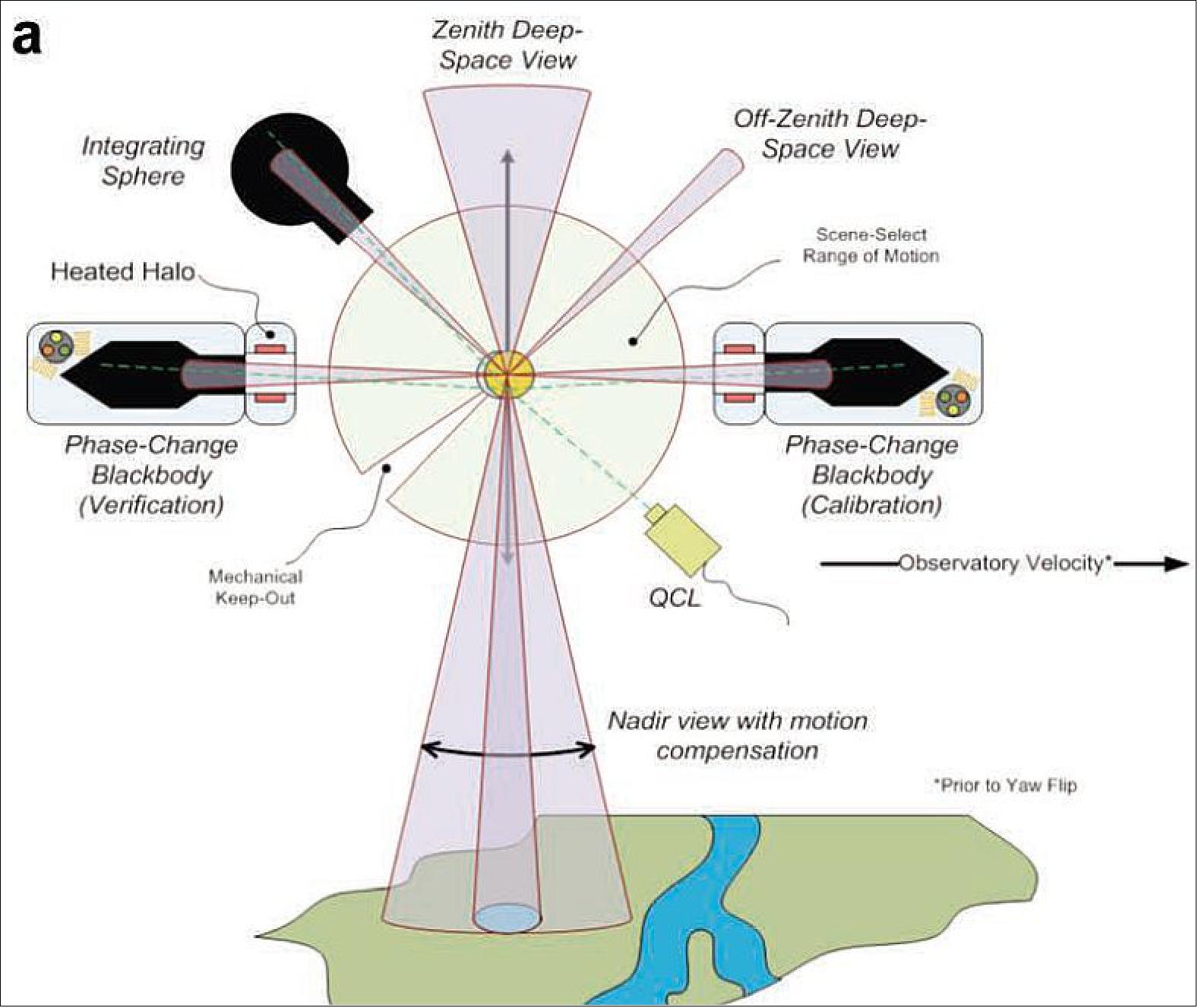
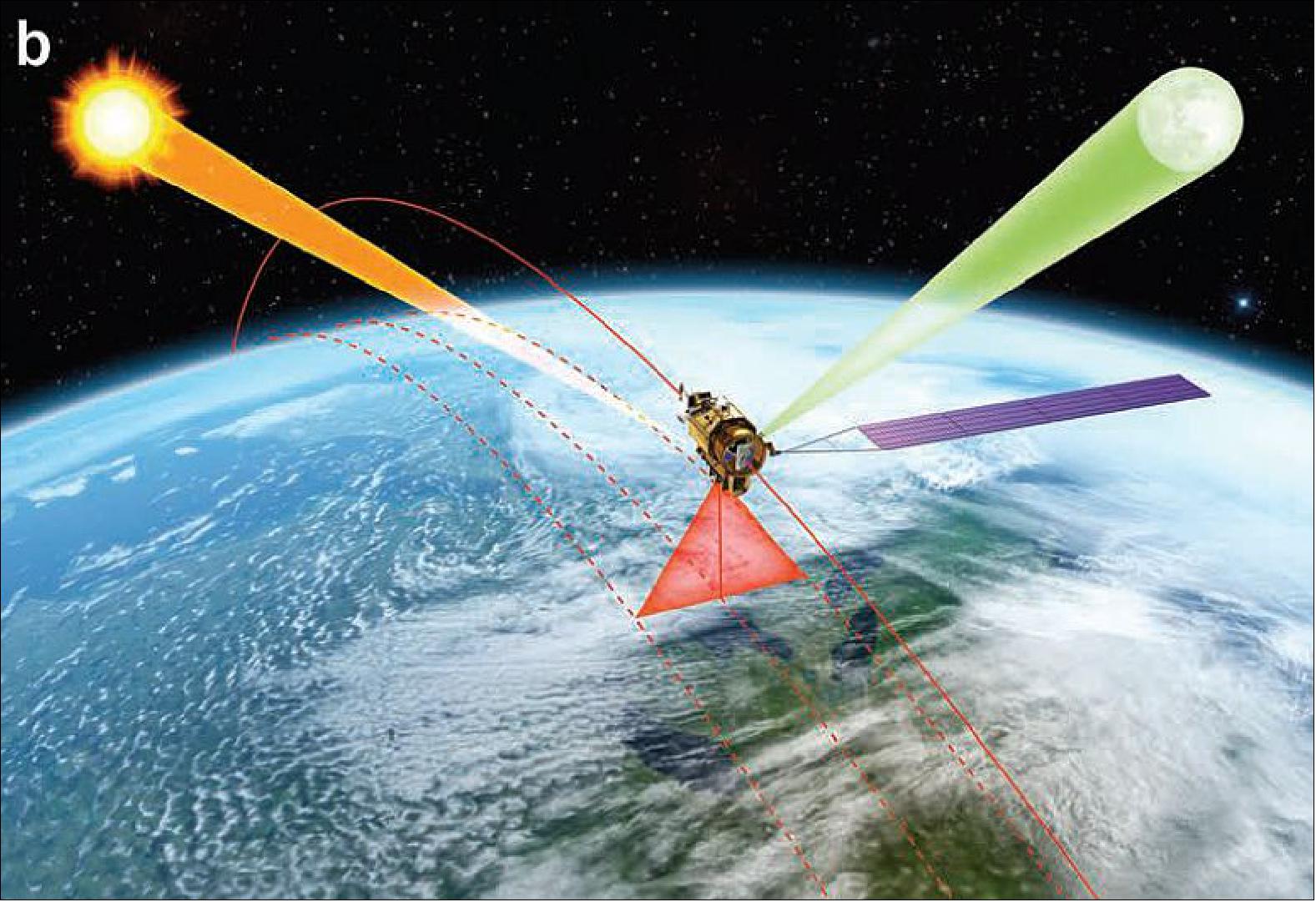
Accuracy requirements for climate change observations: With its absolute accuracy, CLARREO data will be relevant to decadal change observations not only 10 years but even 100 years from the start of CLARREO observations. As a result, unlike most missions, CLARREO must consider the impact of its science requirements decades from now. This suggests that requirement metrics be stated in terms of accuracy of decadal change and in terms of time to detect climate change. The former is more relevant to climate model testing, while the latter is more relevant to societal decision making. But how do we decide what accuracy is needed? What metrics do we use? In general, scientists have struggled in making climate monitoring requirements more rigorous. The science diversity of the CLARREO mission (reflected solar, thermal infrared, and radio occultation), along with recent budget challenges, demanded a rigorous approach. The team now describes what evolved from CLARREO science team deliberations—an approach potentially applicable to a wide range of decadal climate change observations.
The critical insight is that even a perfect observing system for measuring long-term forcing and climate response is fundamentally limited by the noise of natural variability. Such variability includes a range of time scales: ENSO (3–5 years), solar irradiance and sunspot cycles (11 years), and the Arctic Oscillation, North Atlantic Oscillation, and Pacific decadal oscillation (10–30 years). ENSO’s importance is recognized by the IPCC with a 5-year running means for comparisons of decadal change datasets. While ensemble techniques can reduce noise from natural variability in climate model predictions or hindcasts, all observed trends are subject to the confounding noise of natural variability. This means that there is a “floor” for required accuracy in climate trends: the observations need to have uncertainties smaller than, but of comparable magnitude to, natural variability. The key, therefore, is to quantify the relationship between natural variability and observing system accuracy.
Trend uncertainty | IR/RO temperature trends | RS CRF (Cloud Radiative Forcing) trends | ||
Uncertainty source | σ (K) | τ (year) | σ (CRF) | τ (year) |
Natural variability | 0.085 | 2.3 | 0.60 | 0.8 |
Calibration uncertainty | 0.03 | 5 | 0.15 | 5 |
Orbit sampling uncertainty | 0.018 | 1 | 0.21 | 1 |
Instrument noise uncertainty | 0.005 | 1 | <0.01 | 1 |
Table 3: Sources of climate trend uncertainty using global annual mean observations (Ref. 9)
An example is given of how to use climate trend uncertainty in determining the absolute accuracy requirement of CLARREO’s infrared and reflected solar spectrometers. These spectrometers will represent the greatest advance in accuracy over current instruments in orbit.
The accuracy of temperature trends is first considered using the infrared spectrometer. Depending on the infrared wavelengths chosen, trends could be examined for near-surface mid-troposphere, or stratosphere temperatures. The trend uncertainty δm (listed in Table 3) includes natural variability, absolute calibration uncertainty, instrument noise, and orbit sampling uncertainty. Figure4 (a) demonstrates several key points about climate observations. First, trend accuracy increases with the length of the climate record, even for a perfect observing system, because of the need to average out noise in the climate system. Note that the IPCC predicted a global surface air temperature and tropospheric air temperature increase for the next few decades of roughly 0.2 K/decade. A climate record of 12 years is required to reach a trend uncertainty of 0.2 K/decade at 95% confidence, even for a perfect observing system. This shows dramatically the necessity of long climate records in understanding climate trends. To reach a 95% confidence level of 0.1 K/decade (i.e., smaller than the expected trend) requires a 20-year climate record for perfect observations and 22 years with CLARREO accuracy. These results reaffirm that records shorter than 20 years contain little information on global temperature trends.
Absolute calibration accuracy has a dramatic effect on climate trends (Figure 4 (a). The CLARREO requirement is 0.06 K (k=2) or equivalently 0.1 K (k=3). At this absolute accuracy even short gaps do not significantly affect the climate record’s accuracy . In fact, the trend accuracy is very close to that of a perfect observing system. Improving the CLARREO accuracy by a factor of 2 to 0.03 K (k=2) has little effect and clearly reaches the point of diminishing returns. But degrading the CLARREO accuracy by a factor of 2 to a value of 0.12 K (k=2) would degrade trend accuracy by more than 20%, and would increase from 22 to 26 years the time to detect a trend of 0.1 K at 95% confidence. Figure 4 (a) shows that every degradation of calibration absolute accuracy by an additional 0.06 K delays the time to detect such a trend by 5 more years.
The absolute accuracy of weather spectrometers such as AIRS (Atmospheric Infrared Sounder), IASI, and CrIS ranges from 0.2 to 0.4 K (k=2). For these instruments, the reliance is on much weaker constraints for climate trends: instruments must typically overlap for a year or more, and we must assume instrument calibration stability. Figure 4 makes a worst-case assumption of either short gaps and/or instrument calibration drifts at the level of the absolute accuracy uncertainty defined for each instrument. This conservative approach is necessary for a result as critical as climate change. It is concluded that absolute accuracy and long climate records are essential to highly robust climate trend observations.
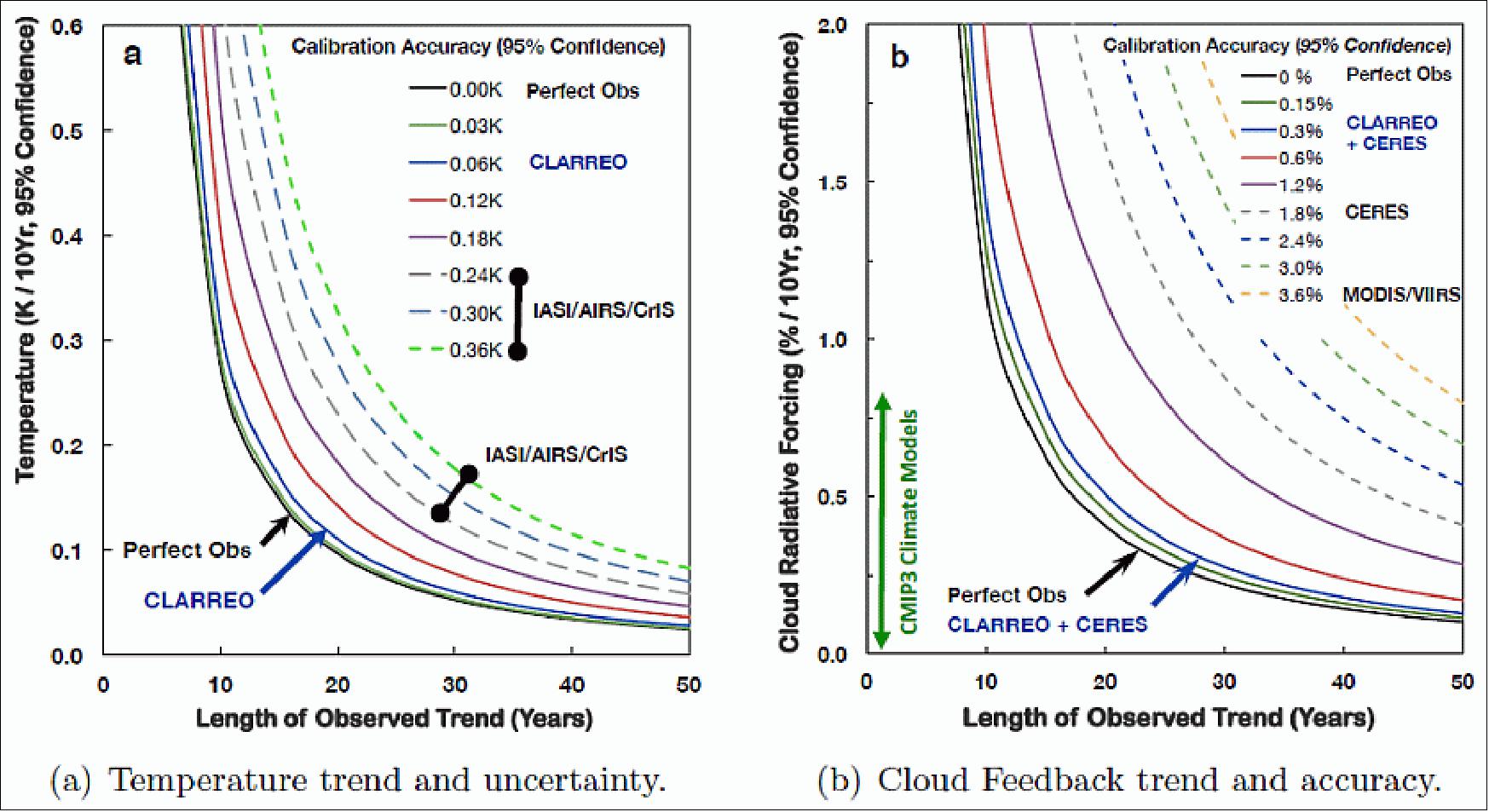
Legend to Figure 4: The results are shown for a perfect observing system as well as varying levels of instrument absolute calibration. The relationship between infrared (IR) spectra accuracy and temperature trends is shown in (a), while the relationship between reflected solar (RS) spectra accuracy and changes in cloud feedback is shown in (b). This illustrates the dramatic effect of measurement accuracy on both climate trend accuracy (vertical axis) as well as the time to detect trends. CLARREO's accuracy is a factor of 5 to 10 better than the absolute accuracy of current instruments in the RS, and a factor from 2 to 3 of existing IR instruments. Accuracy improvements beyond CLARREO have little difference when compared to a perfect observing system, which is shown by the black line in both figures (Ref. 24).*
Figure 4 (b) shows the analogous result for the reflected solar spectrometer. Again, absolute calibration uncertainty dominates the accuracy of global average trends. Uncertainty in climate sensitivity is driven primarily by the uncertainty in cloud feedback, which in turn is driven primarily by low cloud changes varying Earth’s albedo. One can derive a simple metric of cloud feedback for reflected solar by considering the trend in global mean shortwave cloud radiative forcing (SW CRF). The global mean SW CRF is simply the difference between all-sky and clear-sky reflected flux.

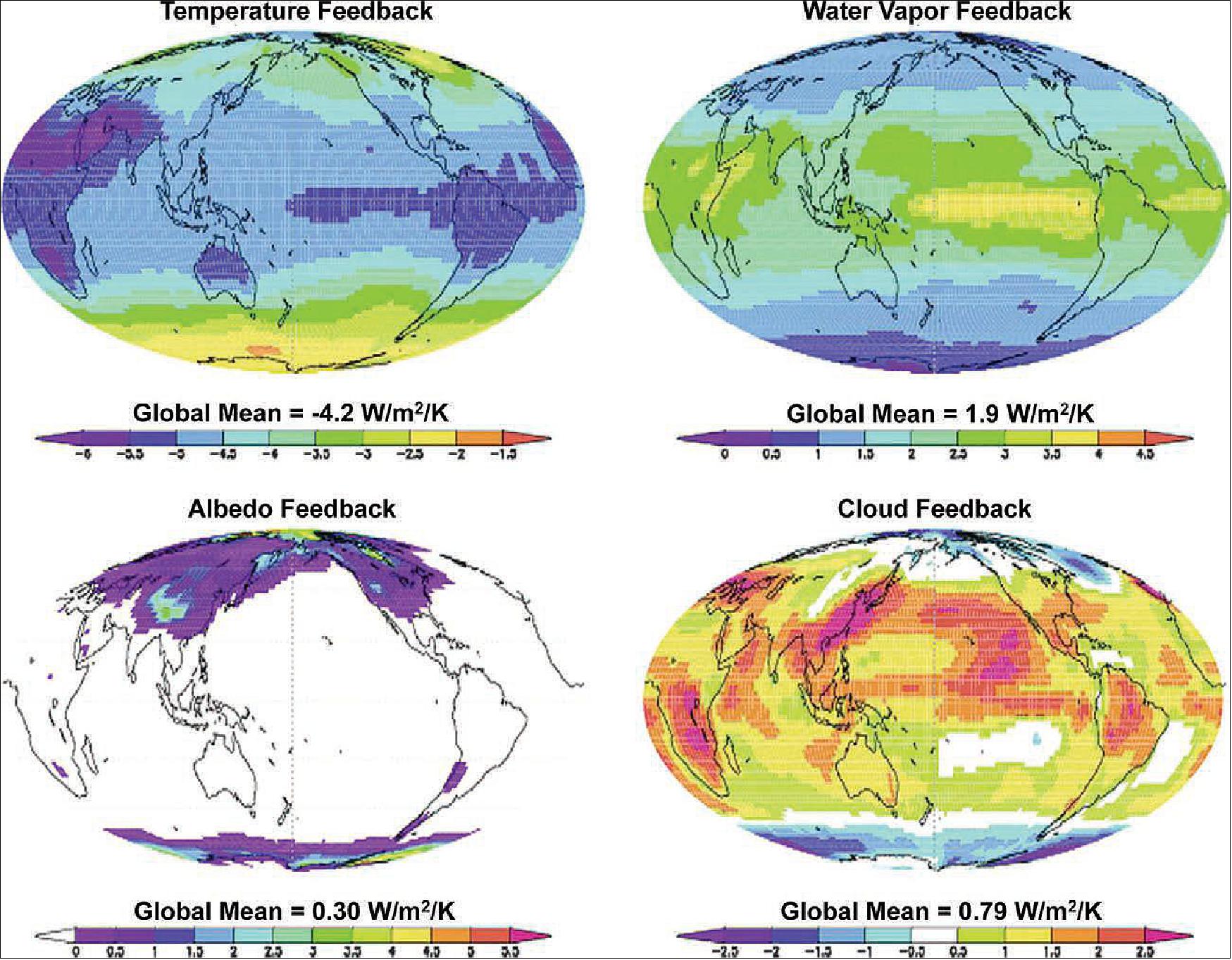
Spacecraft
A description of the CLARREO spacecraft will be provided when available.
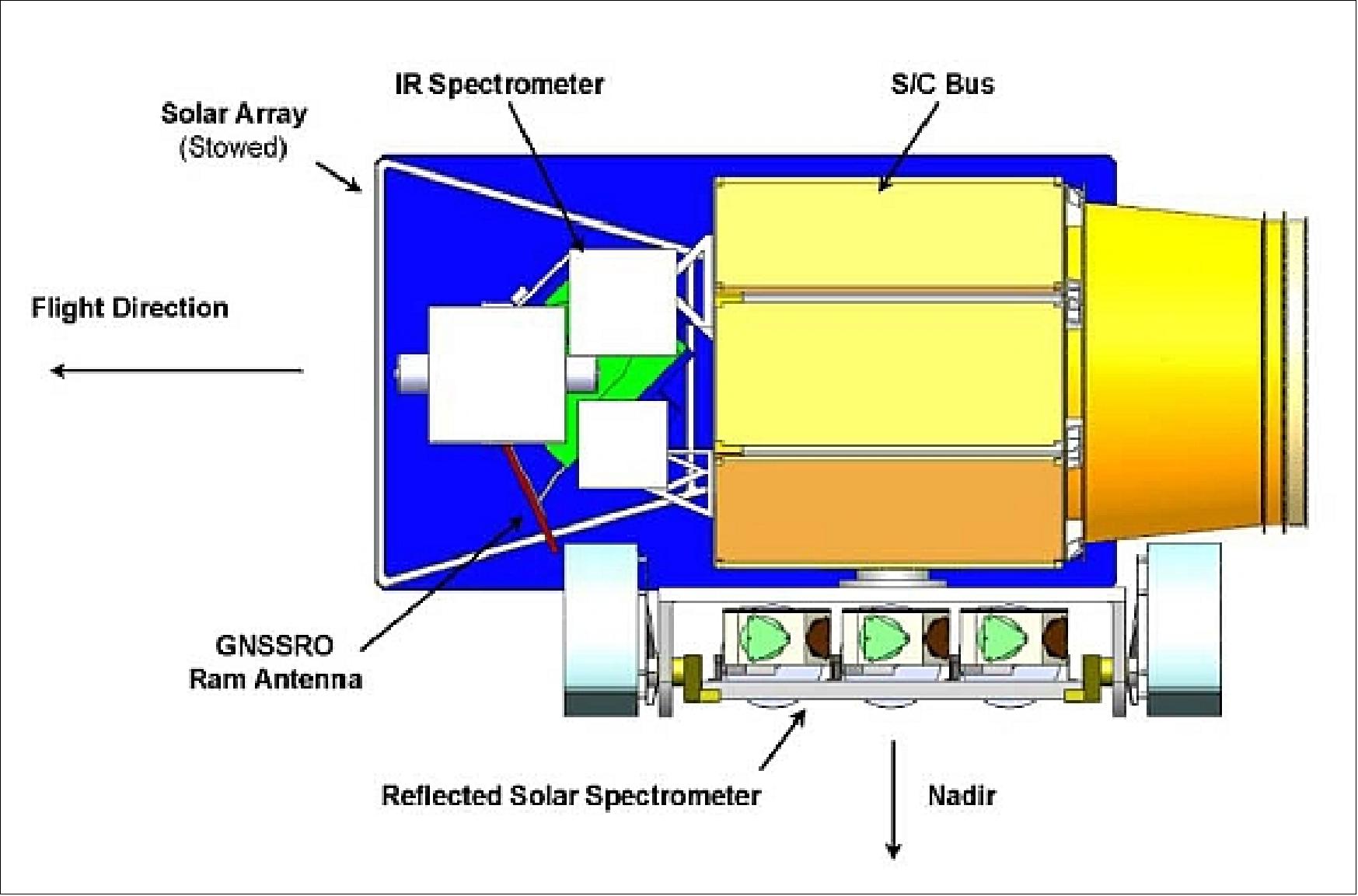
Launch
A launch of CLARREO-1 is planned for the timeframe 2023 or later.
Note: Launches were planned for 2018 and 2020. Unfortunately, in early 2011, reductions in NASA’s Earth science budget required that the launch be delayed to no earlier than 2022. While this is unfortunate, space missions are often delayed because of cost overruns of earlier missions or changes in NASA budget plans (Ref. 9).
Orbit of CLARREO:
- Mean altitude = 609 km (61-day ground track repeat cycle)
- Period = 5812.4 ± 0.25 seconds (orbit maintenance requirement)
- Inclination = 90°
- RAAN = 0° or 180° (for reference inter-calibration)
Sensor complement
ARI (Absolute Radiance Interferometer)
ARI is an infrared spectrometer designed to serve as an on-orbit radiometric reference with the ultra-high accuracy (better than 0.1 K 3σ- or k = 3 brightness temperature at scene brightness temperature) needed to optimize measurement of the long-term changes of Earth’s atmosphere and surface. If flown in an orbit that frequently crosses sun-synchronous orbits, ARI could be used to inter-calibrate the international fleet of infrared (IR) hyperspectral sounders to similar measurement accuracy, thereby establishing an observing system capable of achieving sampling biases on high-information-content spectral radiance products that are also <0.1 K 3σ. It has been shown that such a climate observing system with <0.1 K 2σ overall accuracy would make it possible to realize times to detect subtle trends of temperature and water vapor distributions that closely match those of an ideal system, given the limit set by the natural variability of the atmosphere. This paper presents the ARI sensor’s overall design, the new technologies developed to allow on-orbit verification and test of its accuracy, and the laboratory results that demonstrate its capability. In addition, we describe the techniques and uncertainty estimates for transferring ARI accuracy to operational sounders, providing economical global coverage. Societal challenges posed by climate change suggest that a Pathfinder ARI should be deployed as soon as possible. 23)
ARI consists of a Calibrated Fourier Transform Spectrometer (CFTS), calibrated on-orbit in the traditional way using an ambient onboard blackbody reference and a space view, and an On-orbit Verification and Test System (OVTS) that provides end-to-end calibration verification with direct on-orbit traceability to absolute standards. The OVTS consists of fundamentally new subsystems including the On-orbit Absolute Radiance Standard (OARS), On-orbit Cavity Emissivity Modules (OCEMs), and an On-orbit Spectral Response Module (OSRM).
The ARI CFTS measures absolute spectrally resolved infrared radiance with a spectral coverage of 200–2000 cm-1 at 0.5 cm-1 spectral sampling (unapodized) and a radiometric measurement accuracy of <0.1 K (k = 3) brightness temperature at scene temperature. Resolving atmospheric spectral lines allows ARI to provide products for climate trending with much higher information content than those from current radiation budget measurements. While the ARI accuracy requirements are demanding, the overall instrument is relatively simple and low-cost, because of the modest requirements on spatial sampling (25–100 km nadir-only footprints spaced at <200 km) and noise performance. The minimal spatial sampling and noise requirements derive from the need to perform a great deal of spatial and temporal averaging in deriving climate products that suppress natural variability signals for assessing long-term trends. Also, sampling is limited to nadir-only viewing to suppress potential biases connected with variable view-angle sampling.
The Calibrated Fourier Transform Spectrometer (CFTS)
A notional block diagram of the Calibrated Fourier Transform Spectrometer is shown in Figure 7. Photos of the completed ARI sensor prototype are provided in Figure 8. The CFTS is comprised of:
- Ultra-high accuracy blackbody calibration reference source(s). During laboratory and vacuum testing two calibration references are required, while a single onboard calibration reference and a deep-space view are used for flight;
- A scene selection mirror assembly;
- A fore-optics telescope designed specifically for high radiometric accuracy;
- A 4-port cube-corner, rocking arm interferometer with a fiber-coupled diode laser-based metrology system;
- Two aft optics assemblies, 1 at each output port of the interferometer;
- A 77 K multiple semi-conductor detector (450–2000 cm-1) and dewar assembly;
- A very small mechanical cooler for the semi-conductor detector and dewar subassembly;
- A DTGS (deuterated triglycine sulfate) pyroelectric detector (200–1400 cm-1) assembly.

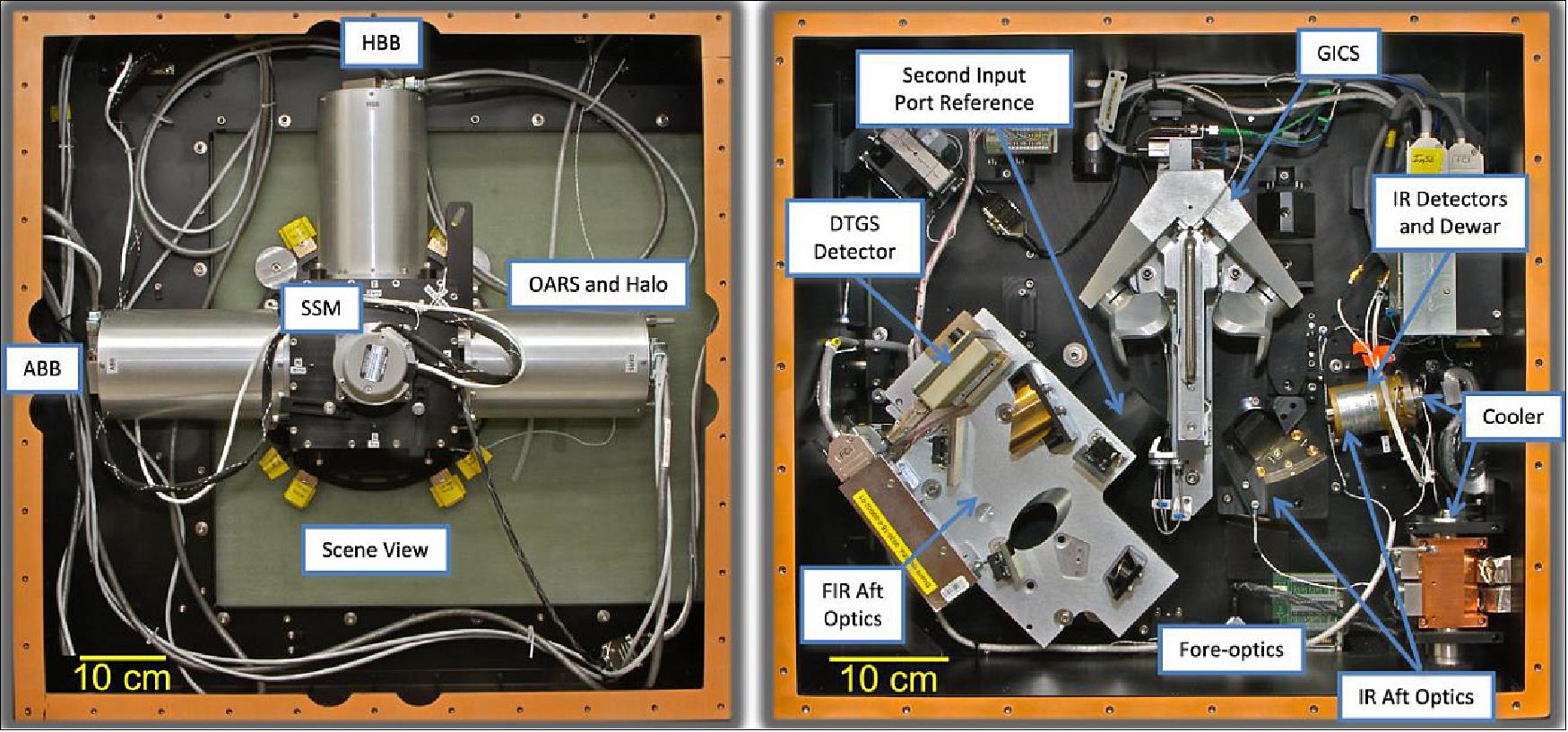
The mission represents a calibration laboratory in orbit for the purpose of accurately measuring and attributing climate change. CLARREO observations establish new climate change benchmarks with high absolute radiometric accuracy and high statistical confidence across a wide range of essential climate variables. The CLARREO benchmarks are derived from measurements of the Earth/atmosphere reflectance (0.32 to 2.3 µm) and the thermal infrared (5 to 50 µm) spectra, and radio occultation from which accurate temperature profiles are derived. CLARREO's inherently high absolute accuracy will be verified and traceable on-orbit to SI (Système Internationale) units. The mission provides the first orbiting reference calibration standard for other radiometric sensors, essentially serving as a NIST (National Institute of Standards and Technology) in orbit. This will significantly improve the accuracy and relevance of numerous spaceborne instruments for decadal climate change. 24)
Objectives: The CLARREO missions will conduct the following observations:
1) Absolute spectrally-resolved measurements of terrestrial thermal emission with an absolute accuracy of 0.1 K in brightness temperature (3σ or 99% confidence limits.) The measurements should cover most of the thermal spectrum.
2) Absolute spectrally-resolved measurements of the solar radiation reflected from Earth. The measurements should cover the part of the solar spectrum most important to climate, including the near-ultraviolet, visible, and near-infrared.
3) Independent measurements of atmospheric temperature, pressure, and humidity using Global Positioning System (GPS) occultation measurements of atmospheric refraction.
4) Serve as a high accuracy calibration standard for use by the broadband CERES instruments on-orbit.
On-orbit Verification and Test System (OVTS)
OVTS provides end-to-end calibration verification with direct on-orbit traceability to absolute standards. The OVTS consists of fundamentally new subsystems including the On-orbit Absolute Radiance Standard (OARS), On-orbit Cavity Emissivity Modules (OCEMs), and an On-orbit Spectral Response Module (OSRM).
OARS (On-orbit Absolute Radiance Standard)
The objective of OARS is to measure Earth’s infrared emission spectrum at very high accuracy and traceable to the international system of units SI (Système International d'Units) and radiometric standards - and to use the CLARREO measurements to cross-calibrate other spaceborne sensors. Instrumentation designed to measure spectrally resolved infrared radiances with an absolute brightness temperature error of better than 0.1 K will require high-emissivity (> 0.999) calibration blackbodies with emissivity uncertainty of better than 0.06% (k=3), and absolute temperature uncertainties of 0.045K (k=3). Key elements of an OARS (On-Orbit Absolute Radiance Standard) meeting these stringent requirements have been demonstrated in the laboratory at the University of Wisconsin and are undergoing further refinement under the NASA IIP (Instrument Incubator Program). 25)
The blackbody design is based on the on-board calibration system developed for the NASA GIFTS (Geosynchronous Imaging Fourier Transform Spectrometer) instrument. A temperature controlled light-trapping blackbody cavity (with a 30 mm aperture) contains thermistor temperature sensors and miniature phase change cells that provide on-orbit temperature calibration. Three or more phase change cells with different reference materials can be used, thus providing multiple calibration temperatures. The heatable conical frustum (heated halo) out in front of the cavity provides the broadband source for periodic measurement of emissivity.
These measurements are made by the spectroradiometer that normally views the cavity for calibration verification, but in this case it is measuring the reflected signal of the heated halo. With the knowledge of the heated halo and effective background temperatures, and the solid angle view factor of the cavity view to the halo, the cavity emissivity can be calculated. Laboratory measurements of an OARS type blackbody, with a spectral emissivity greater than 0.999, have been made with uncertainties less than 0.0004 (k=3).
Temperature calibration is conducted using melt signatures of miniature phase change cells. Emissivity of the blackbody is measured by the spectroradiometer that views the reflected signal from a heated halo that is located in front of the cavity.
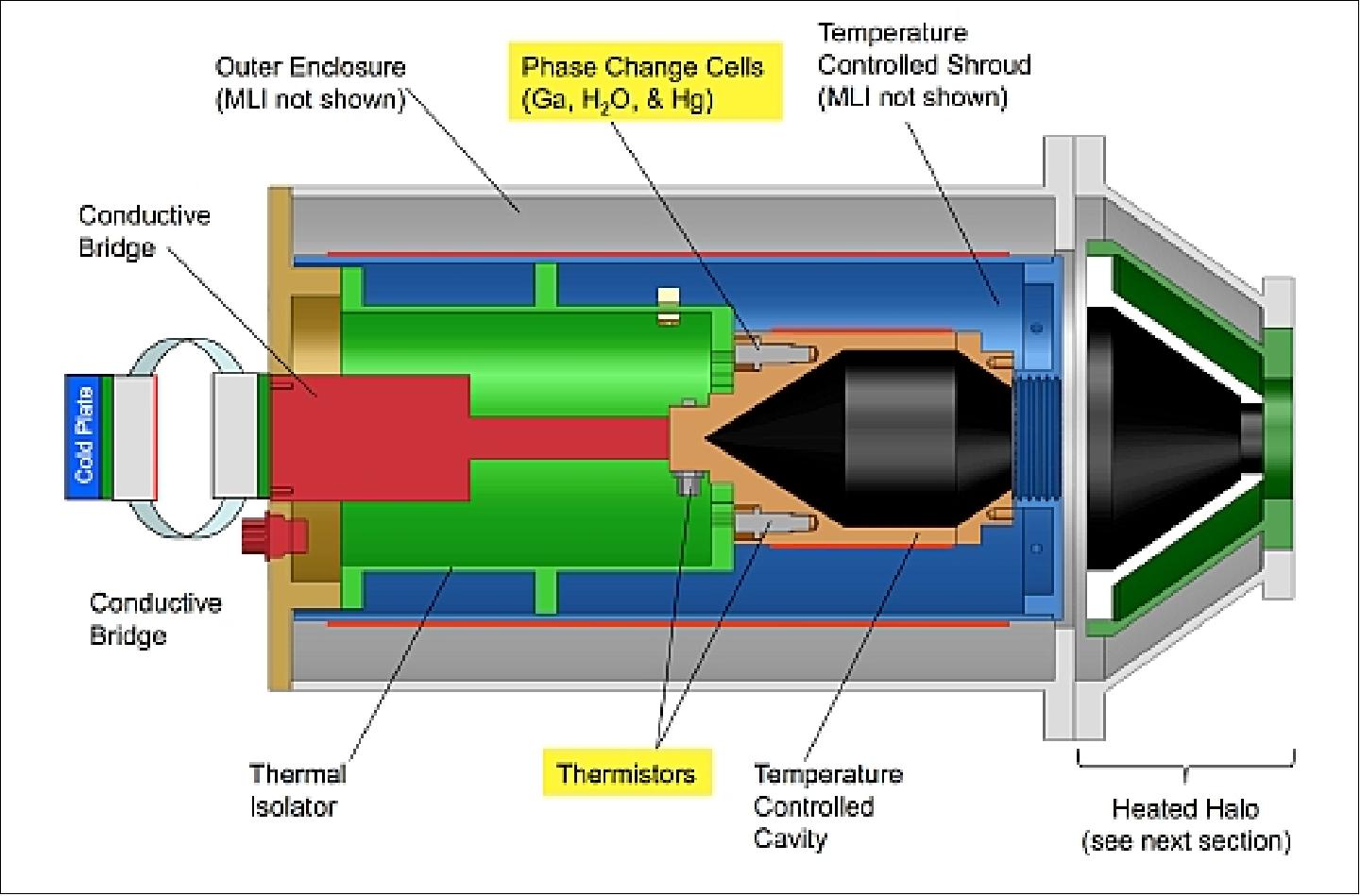
OCEMs (On-orbit Cavity Emissivity Modules)
The OCEMs are providing a source (quantum cascade laser, QCL, or “Heated Halo”) to measure any change in the cavity emissivity of the OARS and calibration reference sources.
DARI (Dual Absolute Radiance Interferometers)
Following the Decadal Survey conclusion, and considering the early development stage of the mission, NASA funded three Instrument Incubator Programs (IIP) to push instrument concepts to a higher level of maturity. A joint proposal between University of Wisconsin (UW) and Harvard University was selected to address the first above objective and part of the fourth one in the corresponding spectral region. 26) 27)
The overall objective is to provide a spectral coverage from 3.3 to 50 µm that can be inter-compared to dissect any unexpected systematic errors in overlapping spectral regions. ABB (ABB Bomem Inc., Québec, Canada) is collaborating with UW (University of Wisconsin, Madison, WI) in order to achieve the DARI goals.
ABB's GFI (Generic Flight Interferometer) has been selected as the favored architecture for the DARI, mainly due to the maturity of the design and its space heritage. A GFI with commercial grade components was optimized for the selected spectral range. The architecture of the GFI will ensure a high response stability between calibrations.
The challenge in the FTS sensor development for CLARREO is to achieve ultra-high accuracy (0.1 K 3σ) with a design that can be flight qualified, has long design life, and is reasonably small and affordable. The GFI consists of interferometer module equipped with metrology optics which forms a single assembly that is entirely free of electronic components apart from the scanning actuator. The power dissipation and the heat imprint of the OMA (Opto-Mechanical Assembly) are thus minimized. This OMA is complemented by a 6U Compact PCI control card that conveys the functionality of metrology detection, laser source, actuator drive, servo control, housekeeping, telemetry and command/data handling.
The interferometer is based on V-shaped scan arm oscillating about a beamplitter. Cube corners are mounted at the extremities of the scan arm (Figure 10). The OMA architecture draws its heritage from a long lived commercial instrument series which started in the mid 80's. This instrument known for its exquisite response stability is used in production plants around the world to provide critical concentration measurements as control feedback for industrial processes.
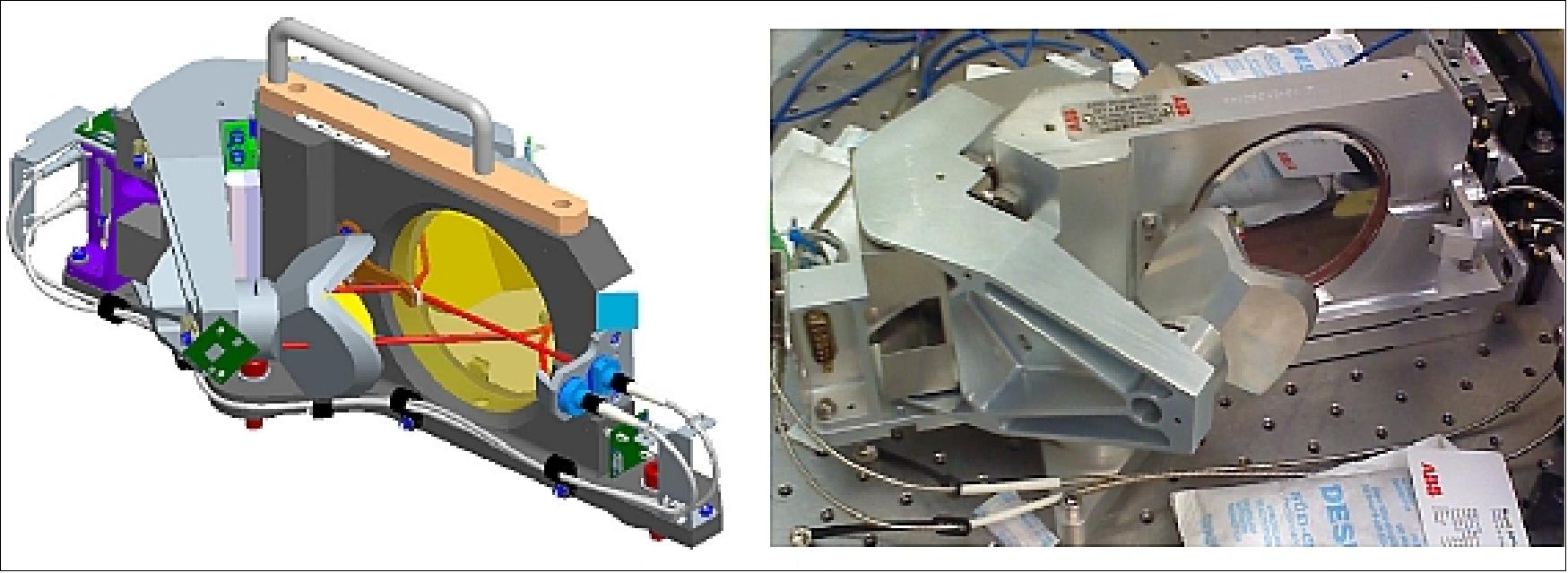
Interferometer type | Dual output and input ports |
Interferometer aperture | 26 mm |
Interferometer divergence | ± 2º |
Optical path difference | Up to ±1.27 cm |
Spectral range | 3 µm – 50 µm |
Spectral sampling interval | ≥ 0.4 cm-1 |
Spectral resolution, FWHM (Full Width Half Maximum) | ≥ 0.86 cm-1 at 475 cm-1 |
Dwell time (scan duration) | 1 – 10 seconds |
Modulation efficiency | 88 % @ 3.26 µm |
Scan speed instability | < 0.13% rms at 2 cm/s of scan speed |
Instrument mass | < 7 kg (aluminium demo) |
Instrument power | Avg: 18 W / Pk: 23 W (flight design) |
Table 4: DARI main characteristics of the interferometer module
At the interferometer level, two important performance characteristics are the modulation efficiency and the speed stability. The modulation efficiency is a measure of how well the interferometer uses the incoming radiation to generate a useful modulated signal. It was measured by sending a collimated beam in the interferometer and then detecting the exiting interference pattern at the output with a photodiode. A chopper was used to distinguish the modulated signal from the unmodulated signal. Narrow optical bandpass filters were used to limit the measurement to specific wavelengths. Measurements were made for 3072 cm-1 and 4237 cm-1. Figure 11 shows one such measurement. At 3072 cm-1, the measured modulation efficiency is (88 ± 2) % and it is (85 ± 2) % at 4237 cm-1. At longer wavelengths, the modulation efficiency will be higher.
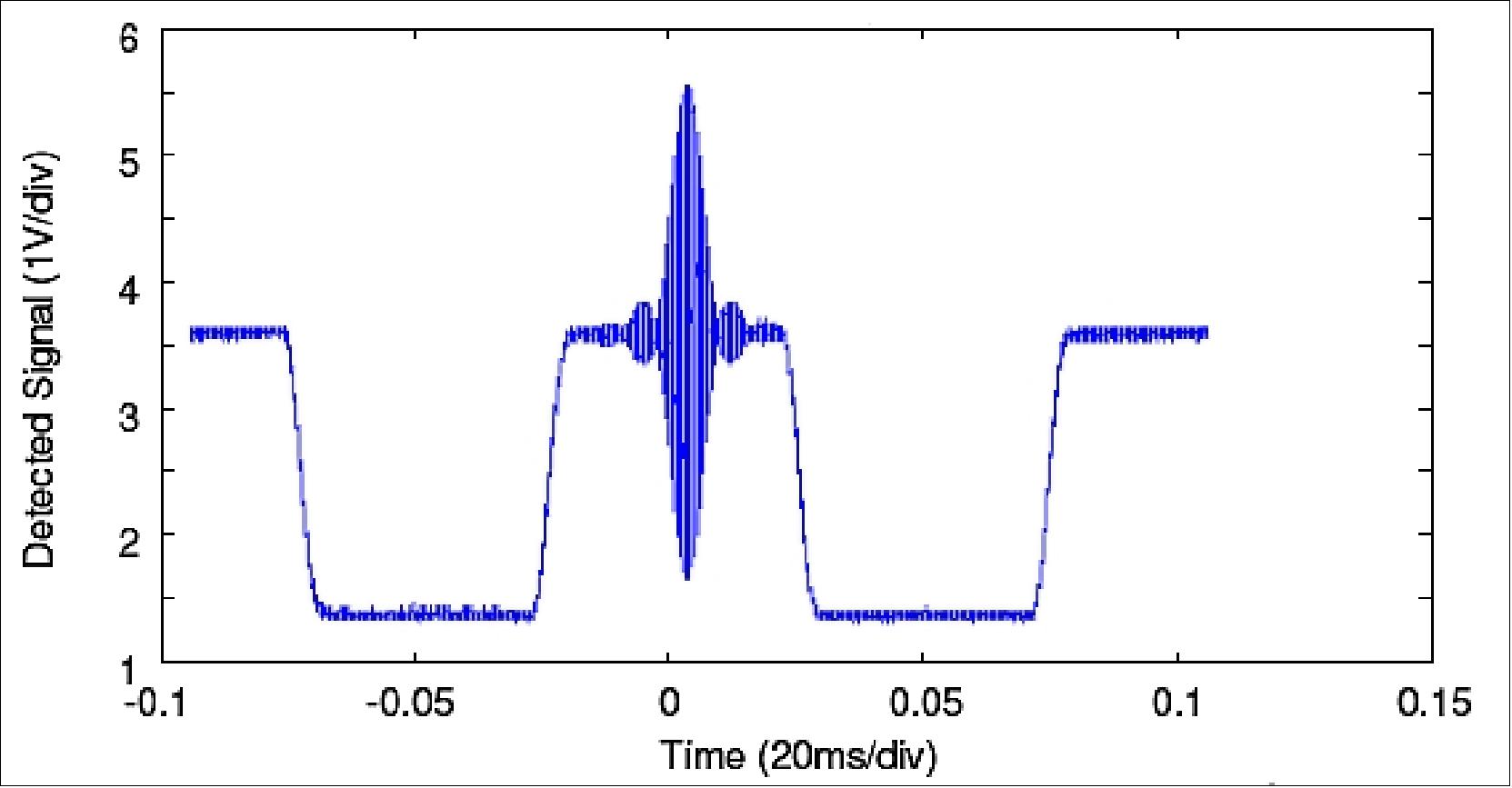
The speed stability of the scan arm is also another important parameter. A better speed stability reduces the contribution of sampling errors to the total radiometric noise in the data. The speed stability was estimated with the signal from the metrology laser. The speed instability was measured to be less than 0.13% rms over the sampling window for both scan directions. Figure 12 shows the scan arm speed during the speed stability test.
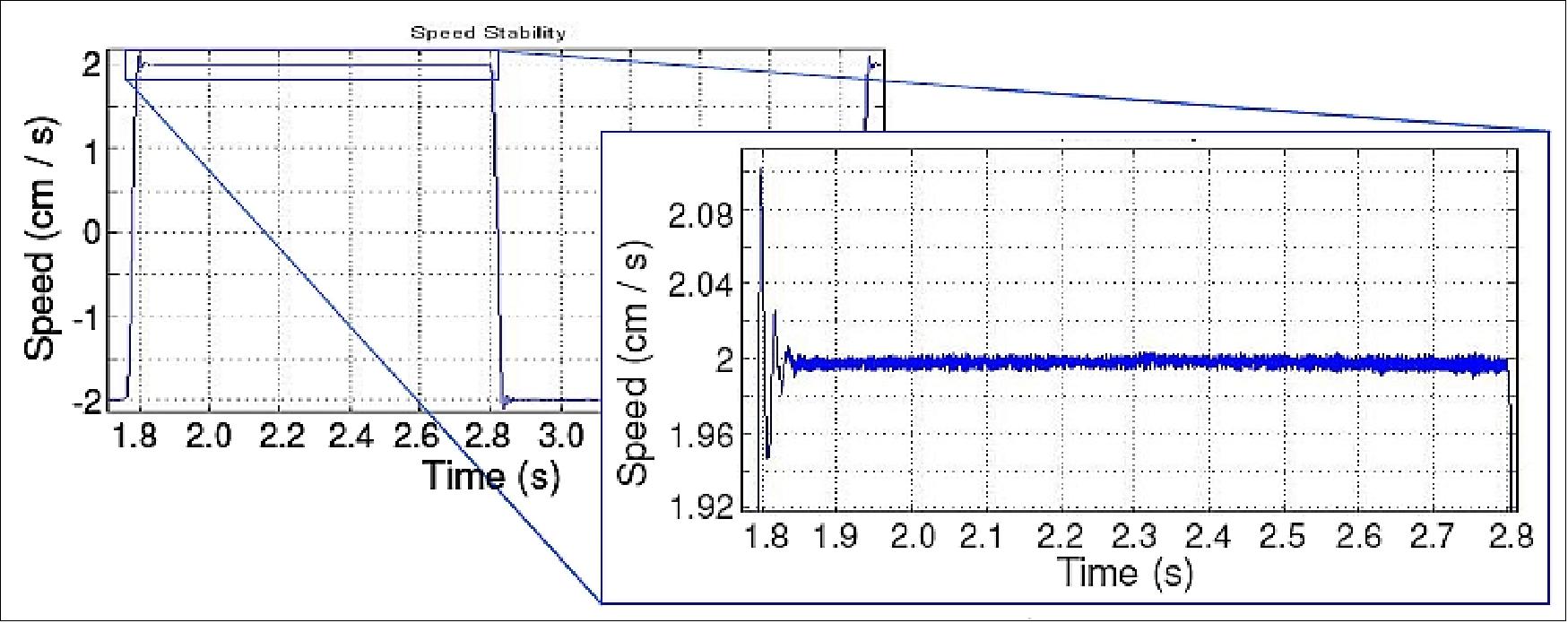
References
1) M. G. Mlynczak, D. G. Johnson, “Enabling Technologies for the CLARREO Mission,” ESTC2008 (Earth Science Technology Conference 2008), June 24-26, 2008, College Park, MD, USA, URL: https://web.archive.org/web/20170513213721/https://esto.nasa.gov/conferences/estc2008/papers/Mlynczak_Martin_B4P2.pdf
2) http://clarreo.larc.nasa.gov/
3) David Young, “CLARREO Overview,” Global Navigation Satellite System Radio Occultation Workshop, Pasadena, CA, April 7-9, 2009, URL: http://www.cosmic.ucar.edu/gnssro/presentations/28_YoungDavidCLARREO_GNSSRO_04_09.pdf
4) Donald E. Anderson, “Draft: Decadal Survey (DS) CLARREO Workshop Report,” October 10, 2007, URL: https://web.archive.org/web/20080916103914/https://nasascience.nasa.gov/earth-science/decadal-surveys/Decadal_Survey_CLARREO.pdf
5) “CLARREO: an Overview,” SORCE’s 5th Anniversary Science Meeting, Santa Fe, New Mexico, February 5-7, 2008, URL: http://lasp.colorado.edu/sorce/news/2008ScienceMeeting/doc/Session4/S4_07_Young.pdf
6) Stephen Sandford, “CLERREO Mission Formulation,” 2009 Decadal Survey Symposium, February 11-12, 2009, URL: https://web.archive.org/web/20090530150518/http://decadal.gsfc.nasa.gov/documents/05_CLARREO.pdf
7) David Young, Chris Currey, “CLARREO Mission Overview and Data System Needs,” NASA Earth Science Data System Working Group Meeting, Wilmington, Delaware, October 20-22, 2009, URL: https://web.archive.org/web/20100528075034/http://esdswg.eosdis.nasa.gov/ppt/CLARREO_for_ESDSWG.ppt
8) Stephen. P. Sandford, David F. Young, James M. Corliss, Bruce A.Wielicki, Michael J. Gazarik, Martin G. Mlynczak, Alan D. Little, Craig D. Jones, Paul W. Speth, Don E. Shick, Kevin E. Brown, Kurtis J.Thome, Jason H. Hair, “CLARREO: Cornerstone of the climate observing system measuring decadal change through accurate emitted infrared and reflected solar spectra and radio occultation,” Proceedings of the SPIE Remote Sensing Conference, Toulouse, France, Vol. 7826, Sept. 20-23, 2010, paper: 7826-33, 'Sensors, Systems, and Next-Generation Satellites XIV,' edited by Roland Meynart, Steven P. Neeck, Haruhisa Shimoda, doi: 10.1117/12.866353
9) Bruce A. Wielicki, D. F. Young, M. G. Mlynczak, K. J. Thome, S. Leroy, J. Corliss, J. G. Anderson, C. O. Ao, R. Bantges, F. Best, K. Bowman, H. Brindley, J. J. Butler, W. Collins, J. A. Dykema , D. R. Doelling, D. R. Feldman, N. Fox, X. Huang, R. Holz, Y. Huang, Z. Jin, D. Jennings, D. G. Johnson, K. Jucks, S. Kato, D. B. Kirk-Davidoff, R. Knuteson, G. Kopp, D. P. Kratz, X. Liu, C. Lukashin, A. J. Mannucci, N. Phojanamongkolkij, P. Pilewskie, V. Ramaswany, H. Revercomb, J. Rice, Y. Roberts, C. M. Roithmayr, F. Rose, S. Sandford, E. L. Shirley, W. L. Smith Sr., B. Soden, P. W. Speth, W. Sun, P. C. Taylor, D. Tobin, X. Xiong, “Achieving Climate Change Absolute Accuracy in Orbit,” BAMS (Bulletin of the American Meteorological Society), Vol. 94, Issue 10, October 2013, pp. 1519-1539, URL: http://journals.ametsoc.org/doi/pdf/10.1175/BAMS-D-12-00149.1
10) “CLARREO Mission Overview,” NASA/LaRC, Jan. 21, 2011, URL: https://web.archive.org/web/20230403104209/https://clarreo-pathfinder.larc.nasa.gov/clarreo/
11) Donald Anderson, Kenneth W. Jucks, David F. Young, ”The NRC Decadal Survey Climate Absolute Radiance and Refractivity Observatory: NASA Implementation,” URL: https://pdfs.semanticscholar.org/5cb1/c1aeb6e4c74b7fe11dbb7bb0ac229717afc6.pdf
12) https://web.archive.org/web/20090117202829/http://nasascience.nasa.gov/missions/clarreo
13) Roger Cooke, Bruce A. Wielicki, David F. Young, Martin G. Mlynczak, ”Value of information for climate observing systems,” Environment Systems and Decisions, Springer, 2014, Vol. 34, pp: 98-109, DOI 10.1007/s10669-013-9451-8.
14) ”Technical Support Document: Social Cost of Carbon for Regulatory Impact Analysis Under Executive Order 12866,” IWG SCC (Interagency Working Group on Social Cost of Carbon, U.S. government), February2010, URL: https://www3.epa.gov/otaq/climate/regulations/scc-tsd.pdf
15) S. Solomon, D. Qin, M. Manning, Z. Chen, M. Marquis, K. B. Averyt, M. Tignor H. L.Miller (eds.), ”IPCC, 2007a: Climate Change 2007: The Physical Science Basis," Contribution of Working Group I to the Fourth Assessment Report of the Intergovernmental Panel on Climate Change, Cambridge University Press, Cambridge, United Kingdom and New York, NY, USA, 996 pp., URL: http://www.ipcc.ch/pdf/assessment-report/ar4/wg1/ar4_wg1_full_report.pdf
16) ”IPCC, 2014: Climate Change 2014: Synthesis Report. Contribution of Working Groups I, II and III to the Fifth Assessment Report of the Intergovernmental Panel on Climate Change,” [Core Writing Team, R.K. Pachauri and L.A. Meyer (eds.)]. IPCC, Geneva, Switzerland, 151 pp., URL: http://www.ipcc.ch/pdf/assessment-report/ar5/syr/SYR_AR5_FINAL_full_wcover.pdf
17) Roger Cooke, Alexander Golub, Bruce A. Wielicki, David F. Young, Martin G. Mlynczak, Rosemary R. Baize, ”Using the social cost of carbon to value earth observing systems, Climate Policy, DOI: 10.1080/14693062.2015.1110109 , published online on January 11, 2016, URL of abstract: http://www.tandfonline.com/doi/full/10.1080/14693062.2015.1110109
18) D. F. Young, M. G. Mlynczak, K. J. Thome, S. Leroy, C. O. Ao, R. Bantges, F. Best, H. Brindley, J. Butler, R. Cageao, W. Collins, R. Cooke, J. Corliss, J. C. Currey, J. A. Dykema, D. R. Doelling, B. Dunn, D. R. Feldman, D. Goldin, H. Huang, R. Holz, Y. Huang, Z. Jin, D. Jennings, D.G. Johnson, S. Kato, R. Knuteson, G. Kopp, D. P. Kratz, X. Liu, C. Lukashin, A. Lyapustin, A. J. Mannucci, J. McCorkel, N. Phojanamongkolkij, P. Pilewskie, H. Revercomb, J. Rice, Y. Roberts, C. M. Roithmayr, F. Rose, W. L. Smith, Sr., B. Soden, P. W. Speth, T. C. Stone, W. Sun, D. Tobin, X. Xiong, ”The CLARREO Mission - Earth's Climate Change Observations,” CLARREO Science Team Report, Oct. 6, 2015, URL: http://clarreo.larc.nasa.gov/pdf/CLARREO_Science_Team_Report_20151006.pdf
19) “GEWEX Cloud Assessment, Applying CLARREO studies to cloud requirements,” 4th GEWEX Cloud Assessment Meeting, Berlin, Germany, June 22-25, 2010, URL: http://climserv.ipsl.polytechnique.fr/gewexca/dmdocuments/clarreo_weilicki_624.pdf
20) ”CLARREO Mission - Earth's Climate Change Observations,” Executive Summary by the CLARREO Science Definition Team, Feb. 5, 2014, URL: http://clarreo.larc.nasa.gov/pdf/clarreo_exec_summary_20140205.pdf
21) Brian J. Soden, Isaac M. Held, Robert Colman, Karen M. Shell, Jeffrey T. Kiehl, Christine A. Shields, ”Quantifying Climate Feedbacks Using Radiative Kernels,” Journal of Climate, Vol. 21, 2008, AMS, pp: 3504–3520, DOI: 10.1175/2007JCLI2110.1, URL: http://people.oregonstate.edu/~shellk/i1520-0442-21-14-3504.pdf
22) “Climate Absolute Radiance and Refractivity Observatory (CLARREO), CLARREO Mission Overview, January 2010, URL: http://clarreo.larc.nasa.gov/docs/CLARREO_Mission_Overview_January_2010_v4.pdf
23) Joe K. Taylor, Henry E. Revercomb, Fred A. Best, David C. Tobin and P. Jonathan Gero, ”The Infrared Absolute Radiance Interferometer (ARI) for CLARREO,” Remote Sensing, Published: 12 June 2020
24) “CLARREO Mission - Earth's Climate Change Observations,” Executive summary of the CLARREO Science Team, Feb. 5, 2014, URL: http://clarreo.larc.nasa.gov/pdf/clarreo_exec_summary_20140205.pdf
25) Fred A. Best, Douglas P. Adler, Claire Pettersen, Henry E. Revercomb, P. Jonathan Gero, Joseph K. Taylor, Robert O. Knuteson, John H. Perepezko, “On-Orbit Absolute Radiance Standard for Future IR Remote Sensing Instruments,” ESTF 2011 (Earth Science Technology Forum 2011), Pasadena, CA, USA, June 21-23, 2011, URL: http://esto.nasa.gov/conferences/estf2011/papers/Best_ESTF2011.pdf
26) Frédéric Grandmont, Louis Moreau, Hugo Bourque, Joe Taylor, Frédéric Girard, Martin Larouche, James Veilleux, “Instrument Demonstration Effort for the CLARREO Mission,” ICSO 2010 (International Conference on Space Optics), Rhodes, Greece, Oct. 4-8, 2010, URL: http://congrex.nl/ICSO/Papers/Session%206b/FCXNL-10A02-2019740-1-Moreau_ICSO_paper.pdf
27) Frederic Grandmont, Joe Taylor, Hank Revercomb, Henry Buijs, Hugo Bourque, “Instrument Demonstration Effort for the CLARREO Mission,” Proceedings of ASTRO 2010, 15th CASI (Canadian Aeronautics and Space Institute) Conference, Toronto, Canada, May 4-6, 2010